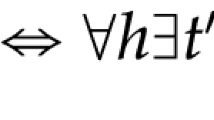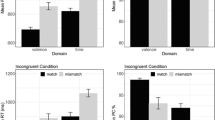Abstract
Young children's comprehension of linguistic reference to past and future times was investigated in two experiments. The children were 2, 3, and 4 years old. The linguistic forms considered were verb tense and the termsbefore andafter; each linguistic form was used in both experiments. The two experimental contexts were (1) actions which either had just occurred or were just about to occur, immediate past and future, and (2) events which either had occurred on the preceding day or were to occur on the following day, more remote past and future. Understanding of linguistic reference to past and future events varied, depending on the situation in which the particular form was applied. Future verb tense was better understood in reference to immediate than to more remote future. Past tense was understood equally well in reference to immediate past action and to more remote past events.Before andafter, both of which would be used to refer to either past or future time, were each better understood when used to refer to the next event or action following the present.
Similar content being viewed by others
References
Bever, T. (1970). The comprehension and memory of sentences with temporal relations. In Flores D'Arcais, G. B., and Levelt, W. J. M. (eds.),Advances in Psycholinguistics, North-Holland, Amsterdam, pp. 285–291.
Bloom, L. (1970).Language Development: Form and Function in Emerging Grammars. MIT Press, Cambridge, Mass.
Bronckart, J. P., and Sinclair, H. (1973). Time, tense and aspect.Cognition 2:107–130.
Clark, E. (1971). On the acquisition of the meaning ofbefore andafter.J. Verb. Learn. Verb. Behav. 10:266–275.
Clark, E. (1973). What's in a word? On the child's acquisition of semantics in his first language. In Moore, T. E. (ed.),Cognitive Development and the Acquisition of Language, Academic Press, New York.
Cromer, R. (1968). The development of temporal reference during the acquisition of language. Unpublished doctoral dissertation, Harvard University.
Harner, L. (1971). Understanding of past and future verb tense by 2-year-old children. Unpublished paper.
Herriot, P. (1969). The comprehension of tense by young children.Child Develop. 40:103–110.
Huttenlocher, J., and Weiner, S. L. (1971). Comprehension in varying contexts.Cogn. Psychol. 2:369–385.
Leech, G. (1970).Towards a Semantic Description of English, Indiana University Press, Bloomington.
Lovell, K., and Dixon, E. M. (1967). The growth of the control of grammar in imitation, comprehension and production.J. Child Psychol. Psychiat. Allied Disciplines 8:31–39.
Slobin, D. (1971). Developmental psycholinguistics. In Dingwall, W.O. (ed.),A Survey of Linguistic Science, University of Maryland Linguistics Program, College Park.
Stern, C., and Stern, W. (1907).Die Kindersprache, Barth, Leipzig.
Werner, H. On early development of expression of time. Unpublished manuscript, Clark University.
Werner, H., and Kaplan, B. (1963).Symbol Formation, Wiley, New York.
Author information
Authors and Affiliations
Additional information
This report is based on a dissertation submitted to Teachers College, Columbia University, in partial fulfillment of the requirements for the Ph.D.
Rights and permissions
About this article
Cite this article
Harner, L. Children's understanding of linguistic reference to past and future. J Psycholinguist Res 5, 65–84 (1976). https://doi.org/10.1007/BF01067949
Received:
Issue Date:
DOI: https://doi.org/10.1007/BF01067949




